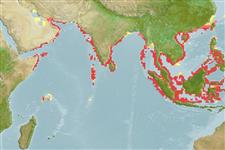Classification / Names
Common names from other countries
Main reference
Size / Weight / Age
Max length : 20.0 cm SL male/unsexed; (Ref. 188); common length : 15.0 cm TL male/unsexed; (Ref. 30573)
Environment
Marine; freshwater; brackish; pelagic-neritic; depth range 10 - 20 m (Ref. 12260)
Climate / Range
Subtropical, preferred 28°C (Ref. 107945); 31°N - 7°S, 49°E - 126°E (Ref. 54426)
Distribution
Indo-Pacific: Persian Gulf (and perhaps south to Somalia), along the coasts of Pakistan, India and Malaysia to Indonesia (Kalimantan) and the Philippines. Earlier records included Dussumieria elopsoides.
Countries | FAO areas | Ecosystems | Occurrences | Introductions
Short description
Dorsal
spines
(total): 0;
Anal
spines: 0;
Anal
soft rays: 14 - 18. Branchiostegal rays fewer (12 to 15) and posterior part of scales marked with numerous tiny radiating striae. Color is iridescent blue with a shiny gold or brass line below (quickly fading after death); hind margin of tail broadly dark. W-shaped pelvic scute; isthmus tapering evenly forward; more anal fin rays.
IUCN Red List Status (Ref. 115185)
Threat to humans
Harmless
Human uses
Fisheries: highly commercial
More information
Common namesSynonymsMetabolismPredatorsEcotoxicologyReproductionMaturitySpawningFecundityEggsEgg development
ReferencesAquacultureAquaculture profileStrainsGeneticsAllele frequenciesHeritabilityDiseasesProcessingMass conversion
Tools
Special reports
Download XML
Internet sources
Estimates of some properties based on models
Phylogenetic diversity index
PD50 = 0.7520 many relatives (e.g. carps) 0.5 - 2.0 few relatives (e.g. lungfishes)
Trophic Level
3.4 ±0.45 se; Based on food items.
Resilience
High, minimum population doubling time less than 15 months (K=0.8-1.2; tmax=1)
Vulnerability
Low vulnerability (14 of 100)
Price category
